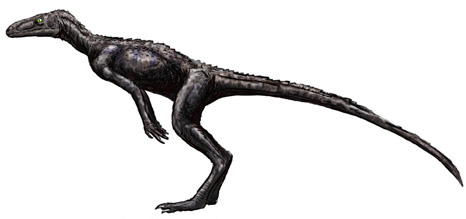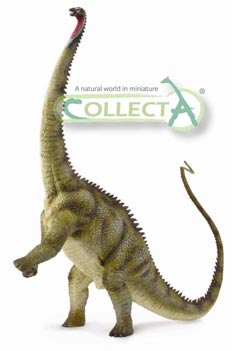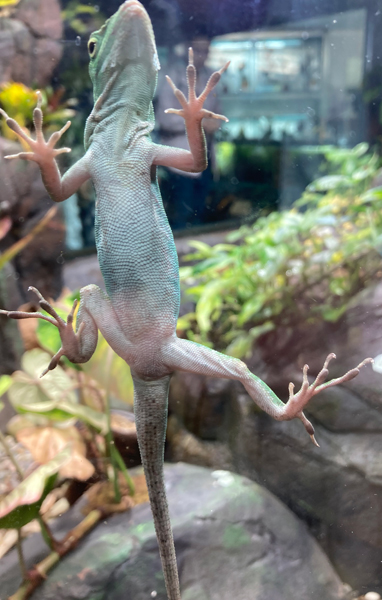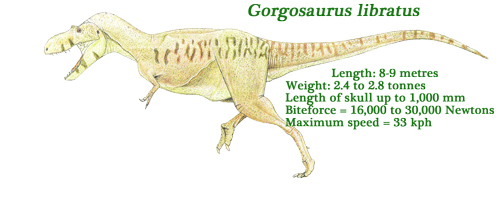Dinosaurs Learn to Stand on Their Two Feet
New Theory as to Why Bipedalism Evolved in the Dinosauria
Iconic dinosaurs such as Tyrannosaurus rex, Velociraptor, Coelophysis and Carnotaurus were all bipeds. That is, they evolved the ability to walk on their hind legs. Bipedalism is a trait that seems to have evolved early in history of the Dinosauria and it is a characteristic that is widespread amongst both lizard-hipped and bird-hipped forms. It had been suggested that bipedalism arose in the ancestors of dinosaurs, to allow the forelimbs to be freed from a locomotive role, allowing them to have other uses, primarily to seize and grasp prey.
However, a team of scientists from the Department of Biological Sciences at the University of Alberta (Canada), have put forward a new theory to explain why some dinosaurs stood on two feet instead of four. The ancestors of the dinosaurs had a “need for speed”!
The Basal Dinosauriform Marasuchus (M. lilloensis) is Typical of a Bipedal Ancestor of the Dinosauria

The basal dinosauriform archosaur Marasuchus of the Late Triassic. A potential ancestor of the Dinosauria.
Picture credit: Pterosauriablog (author Taylor Reints)
The picture above shows the crow-sized Marasuchus, fossils of which come from the La Rioja Province (north-eastern Argentina), specifically from the Chañares Formation. This fast running, bipedal reptile lived some 242 – 235 million years ago and the University of Alberta researchers argue that the presence of big muscles (the caudofemoralis), associated with the back of the legs and tail were central to driving the evolution of bipedalism amongst the archosaurs that were to eventually lead to the evolution of the dinosaurs.
From All Fours to Just Two Legs
Publishing in the academic periodical “The Journal of Theoretical Biology” lead author, Scott Persons and is co-worker Professor Phil Currie, argue that basal dinosauriforms were essentially quadrupeds but they evolved to stand upright, a characteristic that was passed onto their descendants the dinosaurs.
The scientists challenge the idea that bipedalism came about in order to help with the seizing of prey.
Persons stated:
“While that works for some of the very, very early dinosaurs, which were certainly carnivorous, you see a bunch of herbivorous dinosaurs evolve later on and a good many of those groups actually keep their bipedal stance, which is a little strange.”
Big Muscles in the Tail
The researchers argue, that strong muscles at the base of the tail helped to power the hind legs of these prototype dinosaurs. This allowed them to run faster and for longer. Hind legs evolved to become longer, whilst the forelimbs became shorter to reduce body weight and to improve balance and agility. Some of these proto-dinosaurs gave up quadrupedalism entirely.
However, as all young dinosaur fans will happily tell you, there were lots of four-legged dinosaurs, examples being Triceratops, Stegosaurus and Diplodocus. These dinosaurs were herbivores, they evolved heavy defensive weapons, horns and armour which meant that a faster, cursorial lifestyle was sacrificed. As plant-eaters, they evolved ever larger stomachs and digestive tracts to help them process the tough plant material they ate, bigger guts also led to a reversion back to being a quadruped.
Palaeontologist Scott Persons added:
“In the groups where speed was no longer a concern, they often went back to being a quadruped”
A Rearing Diplodocus – A Four-Legged Dinosaur
Picture credit: Everything Dinosaur
The picture (above) shows a rearing Diplodocus in the CollectA model range.
To view this range: CollectA Prehistoric Life Figures.
Studying Sauropods (Dinosauria)
If you take the lizard-hipped, Sauropoda for instance, these herbivores evolved into a myriad of forms, but they all had the same basic body plan and there was a trend towards gigantism within this infraorder. However, it has been suggested that those strong, muscular tails and powerful back legs enabled these dinosaurs to rear up to feed higher up in the vegetative canopy. It has been suggested that baby sauropods may have retained the ability to run on their hind legs, probably to help them escape predators.
To read an article about proposed bipedalism in juvenile sauropods: Facultative Bipedalism in Young Sauropods.
The powerful caudofemoralis muscle provides a greater source of propulsion to the back legs and it is the presence of this tail muscle that may have given the impetus to developing a two-legged stance.
Modern Lizards Provide a Clue
Modern facultatively bipedal lizards offer an analog for the first stages in the evolution of dinosaurian bipedalism. In biology, the term facultative refers to the ability of many organisms to do things by choice rather than by obligation. Facultatively bipedal lizards may spend most of the time on all fours, but when the need arises, such as to escape danger, these reptiles can revert to a bipedal stance. An example of a living facultative biped lizard is the Australian frilled lizard (Chlamydosaurus kingii). Extant lizards are capable of remarkable feats of locomotion.
An Example of a Living Reptilian and Remarkable Locomotion
Picture credit: Everything Dinosaur
Why Don’t Fast Mammals Run on Two Legs?
Biomechanically, running on four legs is more efficient than running on two legs. However, the University of Alberta researchers concluded that the behaviour of synapsid reptiles, distant ancestors of today’s fast running horses, cats, camels, and grey hounds, during the Permian, may explain the lack of bipeds amongst the Mammalia.
In the Permian geological period, it seems some animals started losing the reptilian trait of a strong leg-powering tail muscle. Around that time, many creatures were becoming burrowers, (adapting to a fossorial lifestyle), so they needed strong front limbs for digging. Big back legs and a long, powerful tail would have made it tough to manoeuvre in the confines of a burrow, as well as making it easier for a pursuing predator to snatch them by their tail.
The scientists postulate that living underground may have helped those proto-mammals survive the Permian mass extinction. Their descendants would have evolved to run fast, but without the tail muscles that would have caused them to stand upright.
The Biological Merits of Tetrapods (Not Just the Dinosauria)
Commenting on the biological merits of tetrapods evolving to favour one set of legs for running Scott Persons stated:
“That’s a really funny and strange adaptation. Why would you choose to use just one set of limbs to help you run away when you’re most desperate? And the answer has to do with that great big tail muscle [caudofemoralis]. It effectively sort of overpowers the back legs relative to the front legs. What the lizards are effectively doing is popping a wheelie as they speed off.”
That cursorial advantage explains the relative abundance of cursorial facultative bipeds and obligate bipeds among fossil diapsids and the relative scarcity of either amongst the Mammalia and their close relatives. Having lost their caudofemoralis in the Permian, perhaps in the context of adapting to a fossorial lifestyle, the mammalian line has been disinclined towards bipedalism, but, having never lost the caudofemoralis of their ancestors, the basal dinosauriforms and their relatives were more inclined to adopting a bipedal stance.
A Tale in a Tail! Researchers Explain the Presence of Bipedalism within the Dinosauria
Picture credit: Everything Dinosaur
Visit the award-winning Everything Dinosaur website: Everything Dinosaur.




